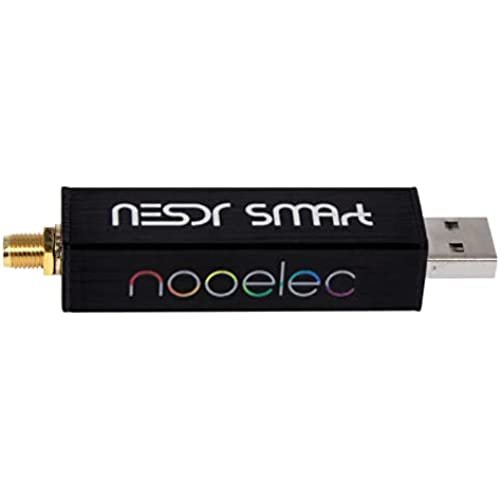
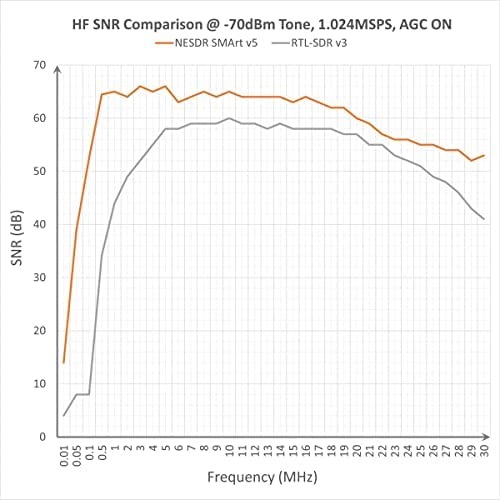
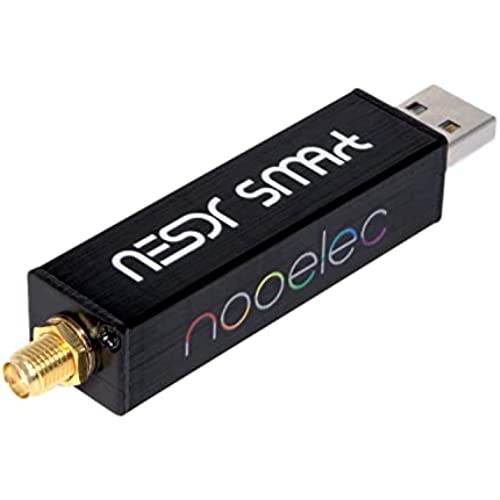
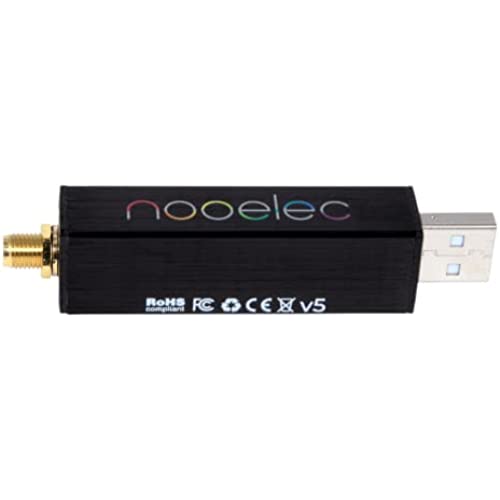
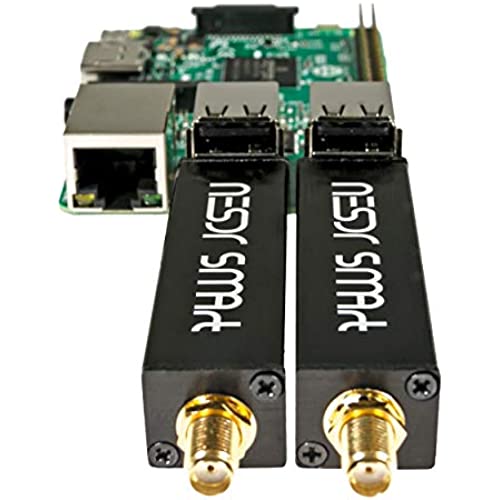
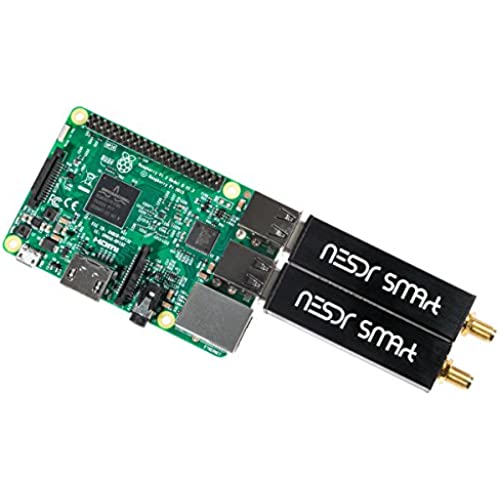






Nooelec RTL-SDR v5 SDR - NESDR Smart HF/VHF/UHF (100kHz-1.75GHz) Software Defined Radio. Premium RTLSDR w/ 0.5PPM TCXO, SMA Input & Aluminum Enclosure. RTL2832U & R820T2 (R860)-Based Radio
-

JP
> 3 dayNice product, although no documentation was provided. Had to look up how to setup on the internet. Some difficulty in getting the software to recognize this SDR due to driver issues. Receive sensitivity could be better. Hooked up to outdoor scanner antenna. Still not receiving signals as strong as my ham radio.
-

rumblee1
> 3 dayI couldnt wait to try this. Bought the hookup cable for my usbc port, the antenna, and downloaded SDR driver, and RF analyzer. Got nothing but noise. And Im in a great radio area. Not even FM. Before giving up, I tried it on my windows 11 computer. But absolutely nothing.
-

Tim
> 3 dayThis is a very complex device . Unless you have computer programming experience , or you are very tech savy , it will be very difficult to install and use this device . If it is not installed properly you can damage your computer . But if you have the technical expertise to install and find the downloads required, then maybe it will work .
-

ddTaylor
> 3 dayIt does what the listing says it does. The quality is very nice especially given the very moderate selling price. I especially appreciate the metal enclosure. Its quality is very solid and the USB and RF connectors are of good quality. The receiver works as well as any other RTL SDR I have used and offers reasonably stable frequency accuracy. I wouldnt expect this radio (or many other SDRs) to be highly accurate above VHF without the option for external reference standards. However, you can account for any frequency inaccuracies in software, so this isnt a real problem even when tracking satellites or performing basic radio astronomy. For the price, this is an excellent way to get your feet wet in SDRs. It is also flexible enough to add LNAs, up-converters, down-converters, filters and even improve the frequency stability through upgraded frequency/time standards. RTL SDRs are not just for getting your feet wet. With some DIY skills and commercially available parts, you can make an RTL SDR function well above its price-point. I like it.
-

BB8
> 3 dayGreat, it works with HDSDR to decode what I want, e.g. HF signal via a Panadaptor, VHF FM radio (standalone), etc. Will explore to decode UHF band signal later...
-

Mark
> 3 dayVery good looking unit. Good luck making the software work. I finally got Airspy to work with it. Took days to figure it out and I am a retired computer tech.
-

Mr. Beau Cole
> 3 dayit does everything I need it to. frees up a two way radio that I typically use to monitor freqs. The high the freq you listen tot he hotter it gets. small CPU fan works well to solve that. not a complaint just a fact of life with electronics.
-

dave71203
> 3 dayas described, neat little receiver has many applications
-

Don
> 3 dayI am using the NESDR as a panadapter with my ham Yaesu FT450D transceiver. I installed a first IF buffer board and rear panel connector on the FT450D. When connected to this dongle, using HDSDR software, this allows the HDSDR software to display a wideband view around the tuned frequency on the transceiver. The device works very well for the purpose. The TXCO temperature compensated oscillator really improves the frequency stability over a cheaper bare-bones device. This insures the frequency displayed on the transceiver and the panadapter agree. The problem with this model is that the four USB contacts within the metal USB connector shell are set too far back from the tip of the connector. The mating socket makes insufficient contact for a reliable connection. The slightest movement of the dongle or extension cable will disconnect the device from the computer. Contact is very intermittent. This problem was on any USB socket or extension cable. Other users have reported the same issue. I contacted Nooelec. While they were somewhat helpful, they seemed unaware of the issue. I finally resolved the problem on my own by filing a few millimeters off of the end of the USB connector with a flat file. This allows the connector on the dongle to insert farther into the socket making reliable connection. No more disconnects.
-

Adam
> 3 dayThe Nooelec RTL-SDR hardware works really well for RF monitoring and experimentation. I’ve bought three so far and they all work great. Very nice and premium-feeling aluminum outer case. Everything was nicely packaged. I’ve run these sticks on a Raspberry Pi for days at a time with no frequency drift. They all worked with zero or minimal ppm correction needed. If you want some RTL-SDR hardware this is a great option. It’s not perfect, though. While it is technically true that you can run two side by side on a Raspberry Pi, in practice I didn’t find this to be very practical. It will cover all four ports so forget about any other peripherals. When run in this configuration, the two SDRs will get really, really hot. With a little extra separation, they get warm but not hot. (I realize these are designed to run hot, but why do that if you don’t have to?) Even though you can run two side by side on a Pi, you’re better off using a USB hub instead in my opinion. The other problem I’ve found is something about the USB-A connectors doesn’t allow them to make a great connection with the host. I’ve tried multiple USB hubs, and of course connected directly to the Pi and in every case the dongles don’t feel like they are held solidly in place. They are quite loose and slightest bump will disconnect them or give a lousy connection to the host until they are wiggled around some to reseat them. This doesn’t appear to be a problem with the USB connector to the circuit board. It’s something with the connector design and how it mates with the ports — almost as if it’s slightly too long. If you plan on using these with a semi-permanent configuration, you should consider a bit of hot glue or epoxy to make sure they are held in place even if bumped around. I’ve had no problems with the SMA connectors and they feel solidly attached. So, in all it’s great hardware let down by a couple unfortunate but not insurmountable design decisions. As long as you keep these things in mind when you purchase, you’ll be fine.
